Delta/Air France has delayed my Nice flight by three hours — an 8:30 pm departure rather than 5:40 pm. That’s okay, I suppose. It affords a little more time to attend to last-minute clean-ups and tweedly-deedlies. My Nice arrival will now be at 11:10 am Tuesday. 2:35 pm update: Delta now says the flight is leaving at 9:30 pm tonight and arriving in Nice at 12:10 pm. Do I hear a 10:30 pm flight and 1:10 pm arrival? Can we go for 11:30 pm departure and a 2:10 pm arrival?
Daily
Good and Bad
D*HOLLYWOOD has posted one-sheets for two Cannes 2010 films — Alejandro Gonzalez Inarritu‘s Biutiful and Olivier Assayas‘s Carlos. I’m sorry but the latter is almost comically bad. It’s akin to those ludicrous internet photos of the devil’s face being formed by smoke from one of the 9/11 explosions. It’s the kind of thing that Cannon Films might have gone with in the mid ’80s. Dump it.
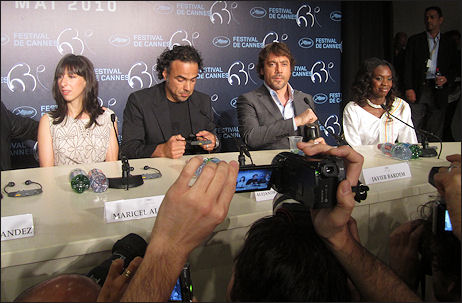
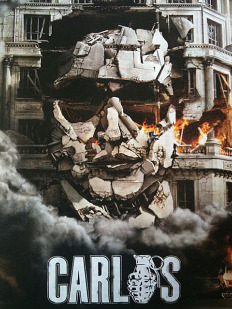
Whimsically Stoned
Doug Liman (Fair Game) will soon direct a 3D Three Musketeers — apparently intended to be a kind of goofball japey Eloi-friendly version in the vein of Sherlock Holmes. This is a futile endeavor in the sense that no one — no one! — will ever out-score or out-attitude Richard Lester‘s The Three Musketeers (’73), which is coming out on a new DVD on 6.1.10. So Liman’s film is double-doomed by way of comparison and the cousin-of-Sherlock Holmes continuity factor. Okay, he’ll probably make a better Musketeers than Stephen Herek‘s version — big deal.
Great Lady
No Lena Horne obituary will be candid enough to say this so I will. She was the first African-American actress-performer to inspire tumescence among mildly racist white guys of the 1940s and ’50s. Horne was a great singer with wonderfully soothing pipes, but she was plain hot besides. The racist joke used to go, “Who would you rather do — Kate Smith or Lena Horne?”
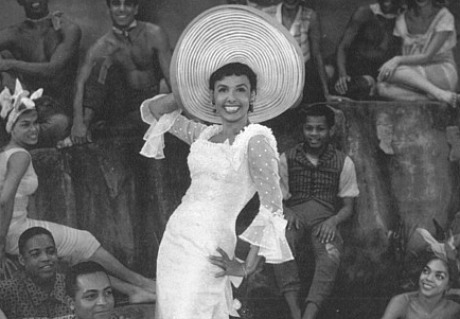
Monday Morning Solution
HE reader Kevin Bowen is wondering if Iron Man 2 might have worked better if it had ended with a cliffhanger in the vein of The Empire Strikes Back. One of the reasons that this second Star Wars film is so highly regarded is that it’s the only franchise actioner in the history of cinema in which the main characters do nothing but lose, lose and lose. Their only heroic accomplishment is escaping with their lives…barely.
“Would Iron Man 2 be a better film if it went the Empire Strikes Back route and had Tony Stark/Iron Man lose, with the third film available for vindication?,” Bowen asks.
“I’m going to say yes. Iron Man 2‘s biggest problem is that the bad guys aren’t particularly threatening or challenging. Mickey Rourke is underdeveloped, and Sam Rockwell, God love him, is too goofball to be a threat. The minute we see robots we know they can never beat a human in a movie.
“If the villains had been more genuinely menacing, the film would be better. If we ended the film with Stark stripped of his suit in captivity or left for dead somewhere, with his rival and his robot army in charge of a fictitous ‘world peace,’ we could have had a cliffhanger worth discussing for a couple years.
“Instead we get just another bland CGI shoot-em-up without much imagination.”
Loach's Last-Minute Cannes Slot
The Cannes Film Festival has added Ken Loach‘s Route Irish, a romantic triangle drama set in Liverpool and Iraq, to the competition slate. Written by Paul Laverty, it’s about two ex-soldiers in love with the same lady. Pic includes “a number of action sequences employing stunts and pyrotechnics — a rare terrain for the British helmer,” says Variety. Chris Menges is the dp. Boning scenes will most likely be subtle or bypassed entirely, given the usual wont of older directors.
Tributing Cardiff
I’ve just been invited to see Craig McCall‘s Cameraman: The Life and Work of Jack Cardiff, on Sunday, 5.16 at 7:45pm — six days hence — at the Salle Bunuel.
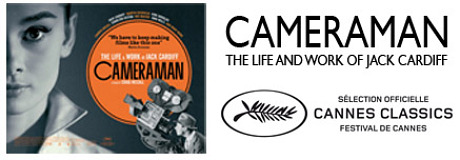
My favorite Cardiff-shot films (in this order): John Huston‘s The African Queen, Richard Fleischer‘s The Vikings, John Irvin‘s The Dogs of War, and King Vidor‘s War and Peace. Oh, and I’ve always had a liking for the look of Girl on a Motorcycle, that late ’60s soft-porny leather-zipper thing with Alaine Delon and Marianne Faithful.
Cameraman screened at the BFI in London last week. It was hosted by the indefatigable Martin Scorsese who described the late director as “one of the last pioneers of filmmaking and one of the first artists who gave us color…he was able to create images of heart-stopping beauty and dynamism…once seen, his images are never forgotten, [and] will never fade.”
"Cut Mahself Shavin'…"
Didn’t play this trailer until yesterday. Apparently decent, mildly appealing, amusing attitude, etc. Supernatural revenge saga by way of Pale Rider and High Plains Drifter. But what’s with the the gopher hole in the right cheek? If I’d produced, I would have said “look, I get it, maimed by a branding iron…but I don’t want the star of my movie walking around with a grotesque hole in his cheek. Eastwood would have never gone for that in his day. It would scare away the ladies.”
Kagan, You Bet
President Obama will certainly nominate Elena Kagan to the Supreme Court, according to an MSNBC news story written by Pete Williams that posted an hour ago.
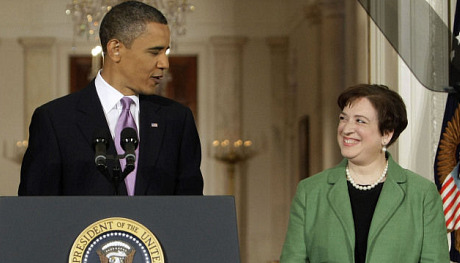
“They stand so low / you got to pick ’em up just to say hello.” — Randy Newman.
Here‘s what I wrote on April 10th: “President Barack Obama‘s likely nominee to replace retiring Chief Associate Justice John Paul Stevens is said to be solicitor general (and former Harvard Law School dean) Elena Kagan.
“The general understanding is that she’s (a) quite brilliant, (b) ideologically centrist if not conservative (Salon‘s Glenn Greenwald wrote yesterday that “replacing Stevens with Kagan would shift the Supreme Court substantially to the right on a litany of key issues”), and (c) openly gay.
“If Kagan is in fact nominated Team Obama will be viewed as having gone the cautious if not vaguely chickenshit route, considering that Kagan’s conservative leanings will make it hard for Republicans to sqawk all that loudly and will deprive them of an election-year issue. Unless, of course, they want to play the anti-gay bigot card.”
Or the anti-overweight card, which Republicans would never exploit given that a sizable percentage of their supporters are fast-food eatin’ plus-size types.
Robin Ain't That Bad
Instead of waiting for Wednesday’s Cannes showing, several critics jumped the gun on Robin Hood today. First came Empire, and then Variety and The Hollywood Reporter stepped in with a little wham-bam, and then came Indiewire‘s Todd McCarthy. And some of them have grumbled a bit, and nobody is quite doing cartwheels in the lobby.
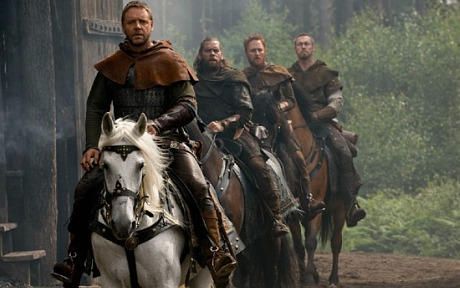
I’m thinking I may as well throw my own two cents in. I mean, the fences are down and this movie needs a friend.
Hasn’t the general Average Joe anticipatory reaction been “what…another Robin Hood? Already? How long ago was the Costner version?” The answer is almost 20 years ago, but I for one am somewhere between fairly and moderately pleased that Ridley Scott’s version doesn’t do the usual usual. It’s an origin story than ends when the other Robin Hood films have begun, and for my meager money it moves along well enough on this particular course. It’s an honorable stab at doing a very familiar thing a bit differently, and since when has that been a crime?
The script is intelligible and intelligent, every frame has been handsomely shot, the production design is first-rate and the cast does its job like the somewhat older pros that most of them are. There are no major under-30 actors in this film except one (i.e., Lea Seydoux as Isabella of Angoulemea) and only a handful of actors iseem to be in their early 30s. Russell Crowe, slimmer than recently but not quite down to his Gladiator weight, has sprigs of gray in his beard, and Cate Blanchett — playing the previously married and widowed Lady Marian — is no spring chicken herself.
No portions of Scott’s film are acutely painful, and almost all of it is, I feel, good enough and often of a very high order (like the French naval invasion sequence). This is a nice “old pro” movie. You’re always aware that you’re in the hands of someone who knows exactly what he’s doing.
Will the Eloi flock to it? Everyone knows the answer to that question, I think. But the Tea Baggers might tell their friends about it because Robin Hood is, philosophically and politically, against tax-and-spend governments and very much with Average Joes. Except Robin Hood’s allies and supporters take care of their teeth and aren’t portrayed as racists so the analogy doesn’t go all the way.
McCarthy calls it “a conjectural origins story about the career birth of England’s legendary people’s outlaw” and says it’s “neither as good as the director’s personal best period epic, Gladiator nor a match for Hollywood’s most memorable previous accounts of the beneficent bandit of Sherwood Forest” but “is, however, superior to the Kevin Costner entry two decades back.
“Earthy, rugged and earnestly advanced in quasi-plausible historical terms, this grandly produced picture can be regarded as something of a tangential sequel to Scott’s ambitious Kingdom of Heaven, with Richard the Lionheart as the connective thread.
“[And yet] what we’re left with is a fashionably gritty period drama, conceived by intelligent minds and handsomely decked out, but featuring no beating heart or compelling raison d’etre.”
AmPav + Shit Year
The talk already is that the American Pavillion is going to be known as year as Shit Year Central with a Cam Archer interview (shared with Myth of the American Sleepover‘s David Robert Mitchell…go, Adam Kersh!) on Saturday the 15th and a Shit Year “Industry in Focus” panel the following day with Archer, costars Ellen Barkin and Luke Grimes, and producers Jay Van Hoy and Lars Knudsen. Get your Shit Year right here!
Seriously, where’s the usual smattering of name-level guests? Apart from Barkin, I mean? Who did the bookings?
Downey's Triumph
I noted last week that I found Robert Downey, Jr.’s appearance in Iron Man 2 irksome. All that base and mascara and tanning spray, and that prissy Van Dyke beard. Today I finally put my finger on it — he has a bit of that Cesare Danova-in-Cleopatra thing going on. That’s the only notable Van Dyke beard performance I could think of, but there must be others. I only know (or feel, at least) that in Downey’s careful clippings and waxy skin something icky this way comes.

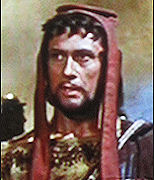
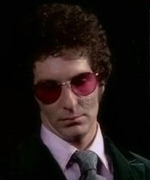
(l. to r.) Robert Downey in Iron Man 2; Cesare Danova in Cleopatra; Leonard Frey in The Boys in the Band.
The fact that Iron Man 2 made $133.6 million this weekend is marketing, of course, but there’s no reasonable explanation for it having earned an “A” with CinemaScore. Not in my head at least. Sooner or later, I also feel, Downey will have to deliver a real performance in a good film and get away from this tentpole franchise crap that has recently consumed his energies. If I could will it with a wave I would have him play “Harold” in William Friedkin‘s The Boys in the Band — the role that Leonard Frey did so well with 40 years ago.
“What I am, Michael, is a 32 year-old, ugly, pock-marked Jew fairy, and if it takes me a little while to pull myself together, and if I smoke a little grass before I get up the nerve to show my face to the world, it’s nobody’s god damned business but my own. And how are you this evening?”
